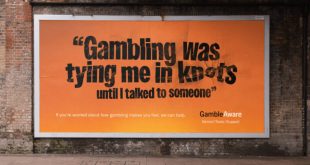Published in its latest interim report, GambleAware has conducted research into the impact that different forms and frequencies of gambling adverts had upon children, young people and vulnerable adults.
The research, carried out by two consortia led by Ipsos MORI and the Institute for Social Marketing at the University of Stirling, found that lotteries and bookmakers are among the highest spenders for gambling advertisements.
Meanwhile, sports advertisements were found to be much more dominant online, with their exposure furthered through sponsorships used within broadcasts of live events.
Marc Etches, CEO of GambleAware, commented: “This is an interim report, and as such it is too early to judge the impact of exposure to gambling advertising and marketing on children, young people and vulnerable adults.
“Nevertheless, the research does make important recommendations, including the need for clearer and more regular messages on gambling adverts of the risks associated with gambling, and the need to strengthen age verification processes on social media platforms.”
The research confirmed that no examples of gambling adverts were placed within children’s media, including the most popular children’s websites. Researchers did find, however, that there was an array of content that contained features which might plausibly appeal directly to children and young people, including celebrity endorsement, memorable songs and catchphrases.
Ian Angus from the Gambling Commission added: “We welcome the publication of this interim report which contributes towards the delivery of the recently launched National Strategy to Reduce Gambling Harms.
“This research takes a significant step to address gaps in understanding of this issue and provides a clearer picture of the volume, tone and content of gambling advertising and sponsorship in Great Britain, and the extent to which children, young people and vulnerable adults are exposed to it.
“We await the findings of the second phase report with interest. In the meantime, we are pleased to see that the report identifies clear areas for action that gambling firms can take now and we therefore expect them to redouble their efforts to address public concerns about the volume and nature of gambling advertising and sports sponsorship.”
59 per cent of eSports gambling content found via Twitter was deemed as potentially appealing to children and young people, mostly attributed to the animated graphics used, in comparison to the11 per cent of gambling adverts found in the mainstream media.
While the research is still ongoing, current figures suggest that young people are still exposed to online gambling adverts, with young people still able to follow and engage with betting-related accounts on Twitter.
GambleAware has expressed that these findings emphasise the room to utilise existing technology which would effectively manage the content that young people and children can access.
Steven Ginnis, Research Director at Ipsos MORI has said: “The research identifies the multiple touchpoints through which children, young people and vulnerable adults come in to contact with gambling marketing and advertising. This stretches from the high street to the lounge and isn’t just restricted to sports.
“The impact of this exposure will be fully explored in our second report. Participants in the research also spoke of a wide range of themes and features that they find appealing in gambling advertising; these features are more commonplace than the use of child-friendly images or phrases, for example the use of celebrities or the use of financial offers.
“This requires a more nuanced discussion of how best to mitigate against the risks of exposure, appeal and susceptibility to gambling advertising among these groups.”
In the research, it was identified that participants felt there was little evidence of prominent consumer protection messages – such as age warnings or promotion of lower-risk gambling. Meanwhile, 22 per cent of mainstream media adverts were judged to contain features such as implied limited risk or inflated chances of winning; which subsequently rose to 37 per cent on Twitter.
The final stages of research, which will be published later this year, the focus will shift towards the overall impact of gambling marketing and advertising strategies.









